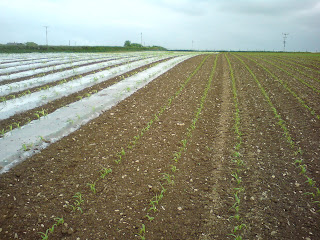Drilled at the same time as the main crop which is Lorado, the earliest high yielding grain maize variety currently available. Please note the highlighted bit, I am not stating that it is the highest yielding variety, just that it's the earliest of the high yielders. This is an often overlooked factor when choosing grain maize varieties, outright yield is often the main selling point. I argue that it's no point growing this grain crop if you are expecting to harvest it in cold wet dark December, when the grain is more often than not contaminated by fusarium and other unpalatable moulds and diseases which spoil quality. Having a variety that will stand all the way through winter is hardly any advantage if the grain is rotten by then! Lorado is good in that it dries down very rapidly and is earliest to finish, when it's ready, don't hang around, go get it. If you wait, it will lodge just below the cob as previous post photo's show although grain loss is actually very small.
Lorado conventionally drilled next to Lorado under plastic. What is really interesting is that the Lorado is emerging better than the maize-under-plastic recommended varieties, as can be seen below.
Lorado emerging in these rows here very evenly and a lot more consistently.
Standard varieties in the first 10 lines, with Lorado on the outside 2 rows. Standard varieties really struggling to punch through the plastic compared to the Lorado.
One of the issues with this system of establishing maize in a dry year can be seen below. The rain has soaked in beautifully into the conventionally planted, but is bone dry under the plastic. The plants which haven't 'punched' through are under tremendous drought stress, are quite brittle in the stems and showing signs of damage. Bizarely the weeds under the plastic are flourishing as they have enough moisture to survive, even though this area has been sprayed with a pre-emergence herbicide. This can be seen in the photo's below.
Struggling to 'punch through' as it's claimed to.
Because the system of laying the plastic, spraying and drilling the seed is so task heavy and complicated, there is no way of banding a starter fertiliser into the seedbed. As a result, the plants have to scavenge for nutrients, something that maize does not do well. This I am sure is holding back growth and therefore inhibiting yield potential. The plants in the picture above this one if you look carefully are actually quite pale, compared to the plants planted conventionally, even though they are larger.
My main concern though looking at the picture above is weed control. Look at how big these weeds above are under the plastic, there is just no way of controlling these, you cannot over spray as the chemical will just land on the plastic sheet and maize just hates any weed competition. It's going to take a really impressive recovery from here to get me interested in spending an additional £160/ac over the conventionally grown grain maize.
Updates will follow, watch this space........






No comments:
Post a Comment